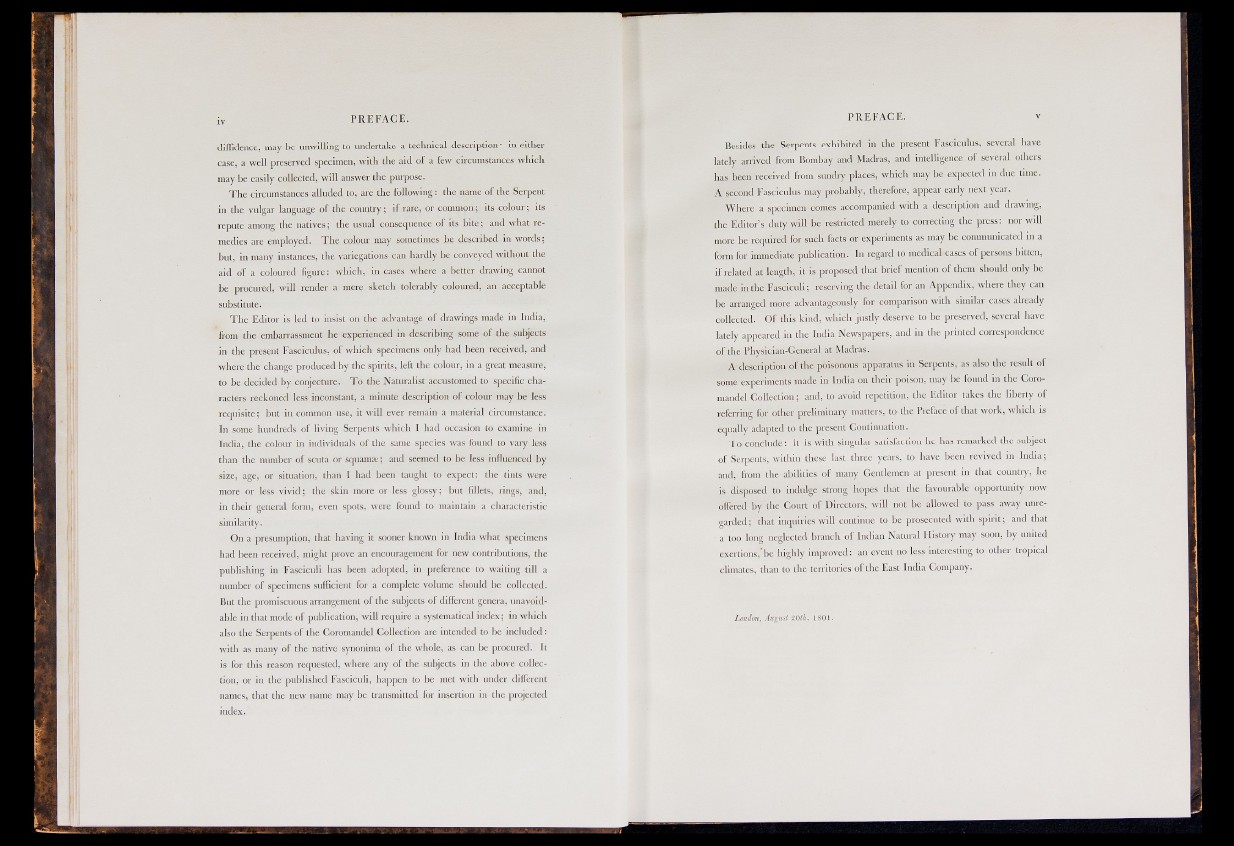
P R E F A C E .
difEdence, may be unwilling to undertake a technical description: in either
case, a well preserved specimen, with the aid of a few circumstances which
may be easily collected, will answer the purpose.
The circumstances alluded to, are the following: the name of the Serpent
in the vulgar language of the country; if rare, or common; its colour; its
repute among the natives; the usual consec]uence of its bite; and what remedies
are employed. The colour may sometimes be described in words;
but, in many instances, the variegations can hardly be conveyed without the
aid of a coloured figure: which, in cases Avhere a better drawing cannot
be procured, will render a mere sketch tolerably coloured, an acceptable
substitute.
The Editor is led to insist on the advantage of drawings made in India,
from the embarrassment he experienced in describing some of the subjects
in the present Fasciculus, of which specimens only had been received, and
where the change produced by the spirits, left the colour, in a great measure,
to be decided by conjecture. To the Naturalist accustomed to specific characters
reckoned less inconstant, a minute description of colour may be less
recjuisite; but in common use, it will ever remain a material circumstance.
In some hundreds of living Serpents which I had occasion to examine in
India, the colour in individuals of the same species was found to vary less
than the number of scuta or squamae; and seemed to be less influenced by
size, age, or situation, dian I had been taught to expect: the tints were
more or less vivid; the skin more or less glossy; but fillets, rings, and,
in their general form, even spots, were found to maintain a characteristic
similarity.
On a presumption, that having it sooner known in India what specimens
had been received, might prove an encouragement lor new contributions, the
publishing in Fasciculi has l^een adopted, in preference to waiting till a
numlDer of specimens sufficient for a complete volume should be collected.
But the promiscuous arrangement of the subjects of different genera, unavoidable
in diat mode of publication, will recjuire a systematical index; in which
also the Serpents of the Coromandel Collection are intended to be included:
with as many of the native synonima of the whole, as can l)e procured, h,
is for this reason requested, where any of the subjects in the above collection,
or in the pubhshed Fasciculi, happen to be met with under diilerent
names, that die new name may Ije transmitted for insertion in the prq|ected
index.
P R E F A C E . V
Besides the Serpents exhibited in the present Fasciculus, several have
lately arrived from Bombay and Madras, and intelligence of several others
has been received from sundry places, which may be expected in due time.
A second Fasciculus may probal^ly, therefore, appear early next year.
Where a specimen comes accompanied with a description and drawing,
the Editor's duty will be restricted merely to correcting the press: nor will
more be required for such facts or experiments as may be communicated in a
form for immediate publication. In regard to medical cases of persons bitten,
if related at length, it is proposed that brief mention of them should only be
made in the Fasciculi; reserving the detail for an Appendix, where they can
be arranged more advantageously for comparison with similar cases already
collected. Of diis kind, which justly deserve to be preserved, several have
lately appeared in the India Newspapers, and in the printed correspondence
of the Physician-General at Madras.
A description of the poisonous apparatus in Serpents, as also the result of
some experiments made in India on their poison, may be found in the Coromandel
Collection; and, to avoid repedtion, the Editor takes the liberty of
referring for other prehminary matters, to the Preface of that work, ^vhich is
equally adapted to the present Continuation.
T o conclude: it is with singular satisfaction he has remarked the suljject
of Serpents, within these last three years, to have been revived in India;
and, from the abilities of many Gentlemen at present in that country, he
is disposed to indulge strong hopes that the fiivouraljle opportunity now
offered by the Court of Directors, will not be allowed to pass away unregarded;
that inquiries will continue to be prosecuted with spirit; and that
a too long neglected branch of Indian Natural History may soon, by united
exertions,'be highly improved: an event no less mteresting to other tropical
climates, than to the territories of the East India Company.
London, Augiisl 20///, ISOI.